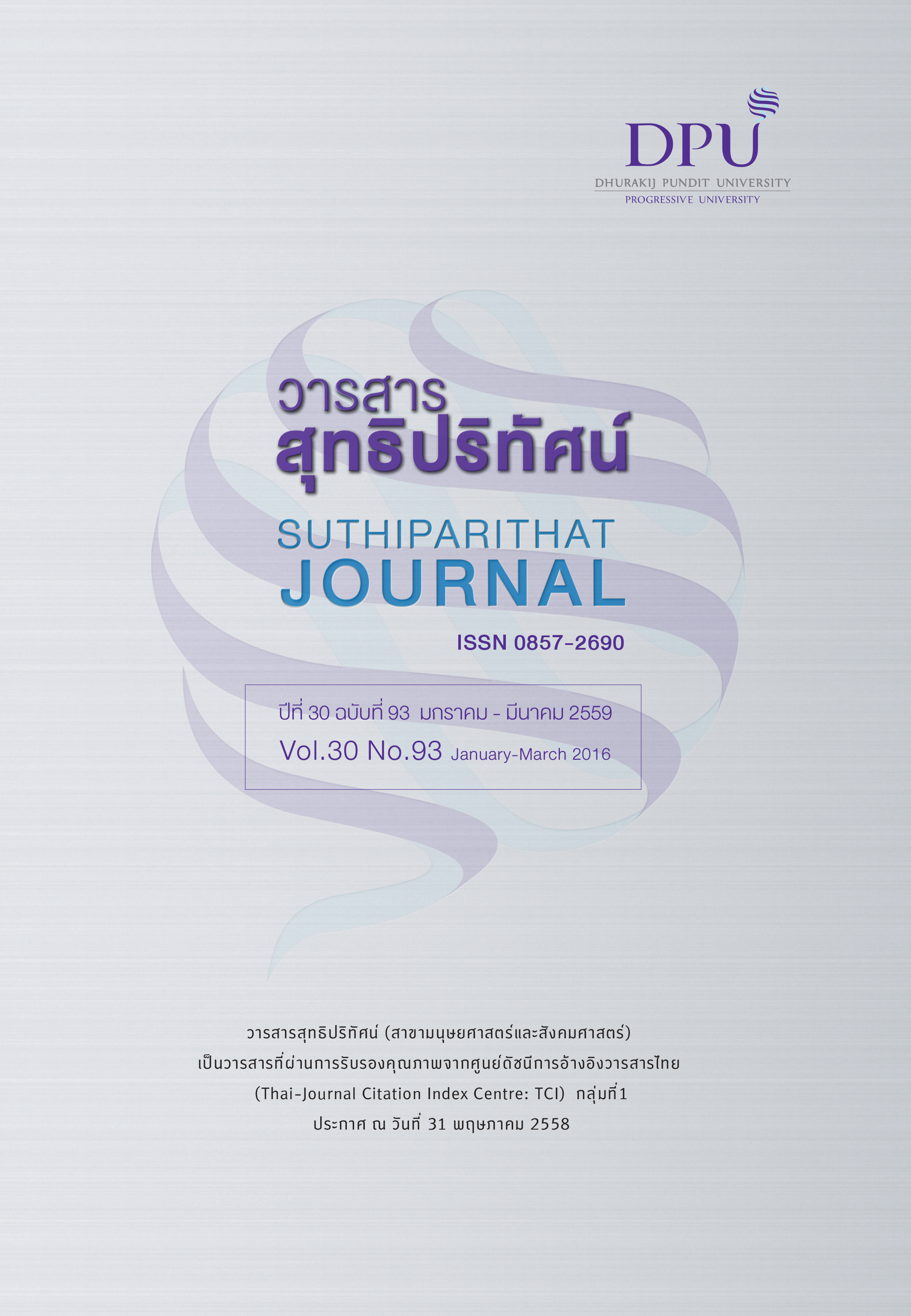THE STUDYING OF CLOUD BUSINESS INTELLIGENCE SYSTEM ARCHITECTURE FOR ASEAN ECONOMIC COMMUNITY
Keywords:
Business Intelligence, Cloud Computing, System Architecture and ASEAN Economic CommunityAbstract
The private and public organizations in Thailand are preparing to deal with ASEAN Economic Community (AEC). Business Intelligence (BI) seems to be the important tools for driving the organizations. However, there is a variety of requirement and needs from executives’ perspectives to be addressed for business adaptation in terms of Business Intelligence adoption. Using BI for business analysis purpose is implementing tools and techniques for transform data into meaningful and useful information for business analysis purpose. Nevertheless, the organizations are facing the several problems such as managing of big data, complexity of system architecture’s design, high total cost of ownership, long-term maintenance, long-time deployment and lack of skillful IT people. Therefore, this leads to new initiatives about data center of business intelligence for AEC‘s member in order to support the business decision making and strengthen the competitive advantage including economic value added.
The purposes of this research are to; compare the system architecture’s design of business intelligence between on premise and on cloud services; propose the conceptual framework of 178 SUTHIPARITHAT Vol.30 No.93 January - March 2016 system architecture of infrastructure, platform and software for business intelligence; and also to study the technology factor for adoption of business intelligence. The qualitative method research was used in this study by using focus group with 12 experts who have skill and experience in information technology. The data analysis used content analysis technique to extract the knowledge from the experts.
The results of this study showed that the system architecture of business intelligence for AEC should adopt cloud service provider for infrastructure, platform and software. In addition, the fee should be charged per usage. Furthermore, the technology adoption of business intelligence are 1) Building user empowerment, 2) Total cost of ownership and time for deployment, 3) Security, 4) Readiness of IT resources, 5) Extraction-Transformation-Loading for Data. In summary, this research reflects the feasibility study for technical aspect of business intelligence on cloud for AEC.
References
กระทรวงเทคโนโลยีสารสนเทศและการสื่อสาร. (2558). กระทรวงไอซีที เดินหน้า Data Center เร่งดึงต่างชาติย้ายฐานลงทุนเข้าไทย. สืบค้นเมื่อ 18 พฤษภาคม 2558, จาก http://www2.moc.go.th/ewt_news.ph.
เพ็ญศิริ มโนมัยสุพัฒน์. (2557). ธุรกิจอัจฉริยะกับความท้าทายในการพัฒนาเพื่อใช้ในองค์กร. วารสารปัญญาภิวัฒน์, 5(2), 236-245.
สมเกียรติ ลีลาทวีวุฒิ. (2557). ปัจจัยขับเคลื่อนการใช้ระบบคลาวด์สำหรับธุรกิจไทยให้ประสบผลสำเร็จ. วารสารสุทธิปริทัศน์, 28(88), 119-144.
ศรีไพร ศักดิ์รุ่งพงศากุล และ เจษฎาพร ยุทธนวิบูลย์ชัย. (2549). หนังสือระบบสารสนเทศและเทคโนโลยีการจัดการความรู้. กรุงเทพฯ: ซีเอ็ดยูเคชั่น.
Adelman, S., Moss, L. & Barbusinski, L. (2002). I found several definition of BI. Retrieved April 1, 2015, from www.dmreview.com.
Al-Aqrabi, H., Liu, L., Hill, R. & Antonopoulos, N. (2012). Taking the Business Intelligence to the Clouds. Proceedings of the 14th IEEE International Conference on High Performance Computing and Communications, Liverpool, 953-958.
Bruque, S. & Moyano, J. (2007). Organizational Determinants of Information Technology Adoption and Implementation in SMEs: The Case of Family and Cooperative Firms. Technovation. 27, 241-253.
Chang, V. (2014). The Business Intelligence as a Service in the Cloud. Future Generation Computer Systems. Retrieved Jun 1, 2015, from http://eprints.leedsbeckett.ac.uk/220/.
Collen, P. (2015). Is TCO still relevant in the cloud? (Electronic Version). CFO forum. Retrieved May 13, 2015, from www.cfo.com/the-cloud/2015/03/tco-still-relevant-cloud/.
Davis, F. D. (1989). Perceived usefulness, perceived ease of use and user acceptance of information technology. MIS Quarterly, 13(3). 319–340.
Eckerson, W.W. (2005). The Keys to Enterprise Business Intelligence: Critical Success Factors. Business Objects. Retrieved April, 1, 2015 from http://download.101com.com/pub/TDWI/Files/TDWI
Ekufu, TG. K. (2012). Predicting Cloud Computing Technology Adoption By Organizations: An Empirical Integration Of Technology Acceptance Model And Theory Of Planned Behavior (Doctoral Dissertation). Minnesota: Capella University.
Low, C., Chen, Y. & Wu, M. (2011). Understanding the determinants of cloud computing adoption. Industrial Management & Data Systems, 111(7), 1006-1023.
Kemper, H. G., & Baars, H. (2006). Business Intelligence and Competitive Intelligence, HMD –Praxis der Wirtschftsinformatik, 247, 7-20.
Nadler, D.A. & Tushman, M.L. (1997). Competing by Design; The power of Organizational Architecture. New York: Oxford University Press.
Paireekreng, W. & Leelataweewut, S. (2015). The Driving Factors for the Implementation of Emerging Cloud Technology in SaaS for Business : A Case Study of Thailand. International Conference on Internet Studies, Tokyo, Japan.
Porter, M. E. (1985). Competitive Advantage: Creating and Sustaining Superior Performance. New York: The Free Press.
Rajan, J. (2009). Business Intelligence: Concepts, Components, Techniques and Benefits. Journal of Theoretical and Applied Information Technology, 9, 60-70.
Reinschmidt, J. & Francoise. (2000). A Business Intelligence Certification Guide, IBM International Technical Support Organization. Retrieved April 1, 2015, from http://www.redbooks.ibm.com/.
Ross, V. W. (2010). Factors Influencing the Adoption of Cloud Computing By Decision Making Managers. (Doctoral dissertation). Minnesota: Capella University.
Sahay, B.S. & Ranjan, J. (2008). Real time business intelligence in supply chain analytics. Emerald, 16(1), 31-32.
Shimba, F. (2010). Cloud Computing: Strategies for Cloud Computing Adoption (Doctoral dissertation). Dublin: Institute of Technology.
Sultan, N. (2010). Cloud computing for education: a new dawn. International Journal of Information Management, 30, 109-116.
Tornatzky, L. & Fleischer, M. (1990). The process of Technology Innovation. Lexington, MA: Lexington Books.
Turban, E., Sharda, R., Delen, D. & King, D. (2007). Business Intelligence, 2nd edition, New Jersey: Prentice Hall.
Weston, R., & Kaviani, S. (2009). Leverage the new infrastructure how market leaders capitalize on Information Technology. Boston: Harvard Business School Press.
Yeoh, W. & Koronios, A. (2010). Critical Success Factors for Business Intelligence System. The journal of Computer Information System, 50(3), 23-32.
Downloads
Published
How to Cite
Issue
Section
License
Content and information of the article published at Suthiparithat Journal are based on the sole opinions and responsibility of author(s) only. Neither the editorial board involve in......







